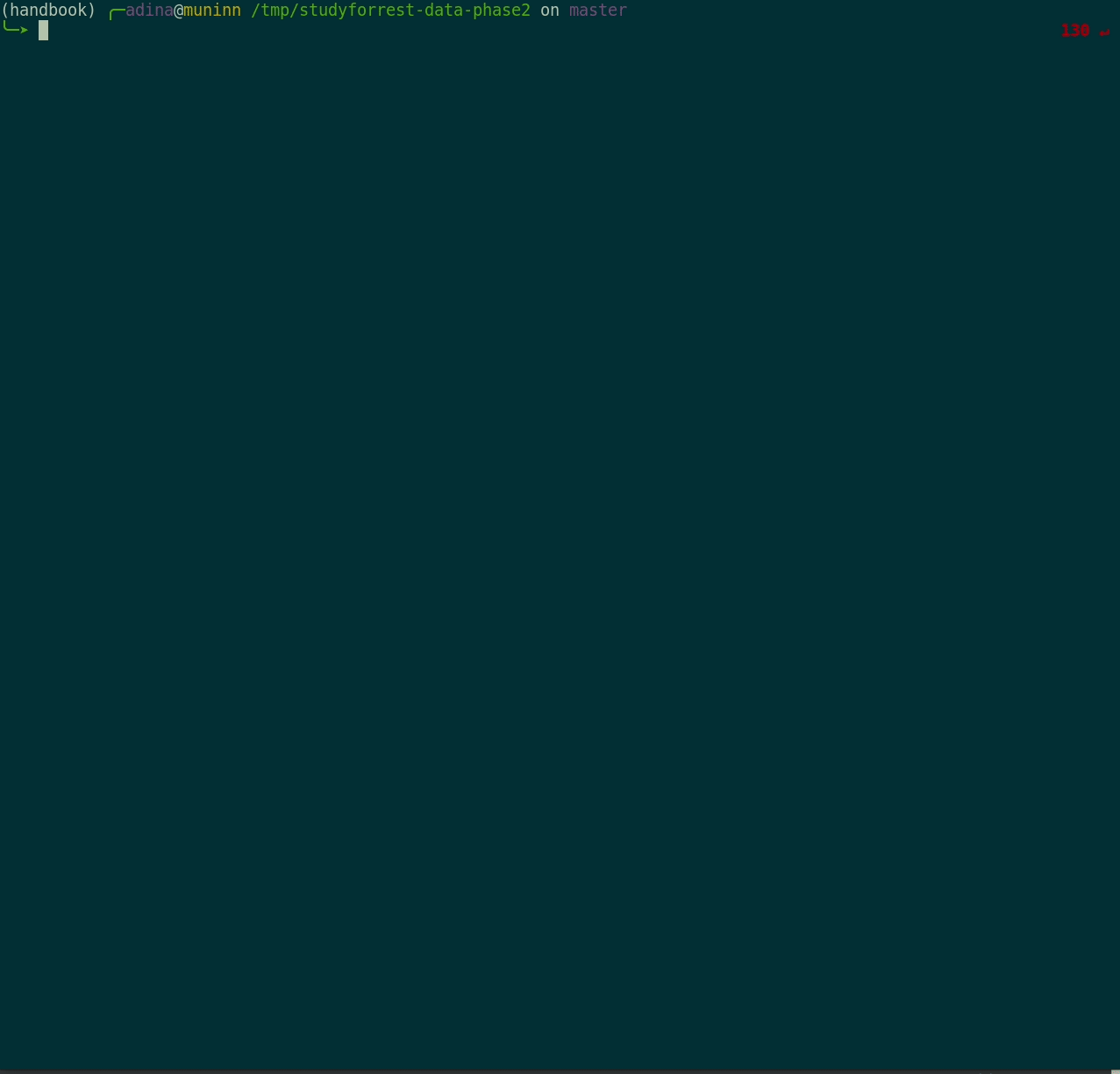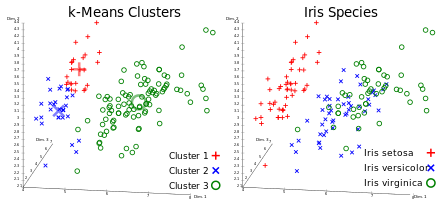DataLad Basics
Code to follow along: handbook.datalad.org/r.html?MPIBerlinPrerequisites: Installation and Configuration
datalad --version
0.13.5$ git config --list
user.name=Adina Wagner
user.email=adina.wagner@t-online.de
[...]
Else, find installation and configuration
instructions at
handbook.datalad.org
Using DataLad
- DataLad can be used from the command line
- ... or with its Python API
- ... and other programming languages can use it via system call
datalad create mydatasetimport datalad.api as dl
dl.create(path="mydataset")# in R
> system("datalad create mydataset")
DataLad Datasets
- DataLad's core data structure
- Dataset = A directory managed by DataLad
- Any directory of your computer can be managed by DataLad.
- Datasets can be created (from scratch) or installed
- Datasets can be nested: linked subdirectories
- Let's start by creating a dataset
DataLad Datasets
A DataLad dataset is a joined Git + git-annex repositoryWhy version control?

- keep things organized
- keep track of changes
- revert changes or go back to previous states
Version Control
- DataLad knows two things: Datasets and files
Local version control
Procedurally, version control is easy with DataLad!
Advice:
- Save meaningful units of change
- Attach helpful commit messages
Start to record provenance
- Have you ever saved a PDF to read later onto your computer, but forgot where you got it from?
- Digital Provenance = "The tools and processes used to create a digital file, the responsible entity, and when and where the process events occurred"
-
The history of a dataset already contains provenance, but there is more
to record - for example: Where does a file come from?
datalad download-urlis helpful
Summary - Local version control
datalad createcreates an empty dataset.- Configurations (-c yoda, -c text2git) are useful (details soon).
- A dataset has a history to track files and their modifications.
- Explore it with Git (git log) or external tools (e.g., tig).
datalad saverecords the dataset or file state to the history.- Concise commit messages should summarize the change for future you and others.
datalad download-urlobtains web content and records its origin.- It even takes care of saving the change.
datalad statusreports the current state of the dataset.- A clean dataset status (no modifications, not untracked files) is good practice.
Questions!
Consuming datasets
- Here's how a dataset looks after installation:
- Datasets are light-weight: Upon installation, only small files and meta data about file availability are retrieved.

Plenty of data, but little disk-usage
- Cloned datasets are lean. "Meta data" (file names, availability) are present, but no file content:
$ datalad clone git@github.com:psychoinformatics-de/studyforrest-data-phase2.git
install(ok): /tmp/studyforrest-data-phase2 (dataset)
$ cd studyforrest-data-phase2 && du -sh
18M .$ datalad get sub-01/ses-movie/func/sub-01_ses-movie_task-movie_run-1_bold.nii.gz
get(ok): /tmp/studyforrest-data-phase2/sub-01/ses-movie/func/sub-01_ses-movie_task-movie_run-1_bold.nii.gz (file) [from mddatasrc...]# eNKI dataset (1.5TB, 34k files):
$ du -sh
1.5G .
# HCP dataset (80TB, 15 million files)
$ du -sh
48G .
Git versus Git-annex
- Data in datasets is either stored in Git or git-annex
- By default, everything is annexed, i.e., stored in a dataset annex by git-annex
| Git | git-annex |
| handles small files well (text, code) | handles all types and sizes of files well |
| file contents are in the Git history and will be shared upon git/datalad push | file contents are in the annex. Not necessarily shared |
| Shared with every dataset clone | Can be kept private on a per-file level when sharing the dataset |
| Useful: Small, non-binary, frequently modified, need-to-be-accessible (DUA, README) files | Useful: Large files, private files |
Git versus Git-annex
Git versus Git-annex
Useful background information for demo later. Read this handbook chapter for detailsGit and Git-annex handle files differently: annexed files are stored in an annex. File content is hashed & only content-identity is committed to Git.
- Files stored in Git are modifiable, files stored in Git-annex are content-locked
- Annexed contents are not available right after cloning,
only content identity and availability information (as they are stored in Git).
Everything that is annexed needs to be retrieved with
datalad getfrom whereever it is stored.
|
|
|
Git versus Git-annex
-
When sharing datasets with someone without access to the same computational
infrastructure, annexed data is not necessarily stored together with the rest
of the dataset (more in the session on publishing).

-
Transport logistics exist to interface with all major storage providers.
If the one you use isn't supported, let us know!
Git versus Git-annex
-
Users can decide which files are annexed:
- Pre-made run-procedures, provided by DataLad (e.g.,
text2git,yoda) or created and shared by users (Tutorial) - Self-made configurations in
.gitattributes(e.g., based on file type, file/path name, size, ...; rules and examples ) - Per-command basis (e.g., via
datalad save --to-git)
Transport logistics
- Disk-space aware workflows: Cloned datasets are lean (only Git):
$ datalad clone git@github.com:datalad-datasets/machinelearning-books.git
install(ok): /tmp/machinelearning-books (dataset)
$ cd machinelearning-books && du -sh
348K .$ ls
A.Shashua-Introduction_to_Machine_Learning.pdf
B.Efron_T.Hastie-Computer_Age_Statistical_Inference.pdf
C.E.Rasmussen_C.K.I.Williams-Gaussian_Processes_for_Machine_Learning.pdf
D.Barber-Bayesian_Reasoning_and_Machine_Learning.pdf
[...]$ datalad get A.Shashua-Introduction_to_Machine_Learning.pdf
get(ok): /tmp/machinelearning-books/A.Shashua-Introduction_to_Machine_Learning.pdf (file) [from web...]$ datalad drop A.Shashua-Introduction_to_Machine_Learning.pdf
drop(ok): /tmp/machinelearning-books/A.Shashua-Introduction_to_Machine_Learning.pdf (file) [checking https://arxiv.org/pdf/0904.3664v1.pdf...]git-annex protects your files
-
If git-annex does not know any other storage location for a file it will
warn you and refuse to drop content (can be configured) - Here is a file with a registered remote location (the web)
$ datalad drop .easteregg
drop(ok): /demo/myanalysis/.easteregg (file) [checking https://imgs.xkcd.com/comics/fuck_grapefruit.png...]
- Here is a file without a registered remote location (the web)
$ datalad drop compiling.png
[WARNING] Running drop resulted in stderr output: git-annex: drop: 1 failed
[ERROR ] unsafe; Could only verify the existence of 0 out of 1 necessary copies; Rather than dropping this file, try using: git annex move; (Use --force to override this check, or adjust numcopies.) [drop(/demo/myanalysis/compiling.png)]
drop(error): /demo/myanalysis/compiling.png (file) [unsafe; Could only verify the existence of 0 out of 1 necessary copies; Rather than dropping this file, try using: git annex move; (Use --force to override this check, or adjust numcopies.)]datalad get can retrieve file content after droppingDataset nesting
- Seamless nesting mechanisms:
- Overcomes scaling issues with large amounts of files
adina@bulk1 in /ds/hcp/super on git:master❱ datalad status --annex -r
15530572 annex'd files (77.9 TB recorded total size)
nothing to save, working tree cleanDataset nesting
DataLad: Dataset linkage
$ datalad clone --dataset . http://example.com/ds inputs/rawdata
$ git diff HEAD~1
diff --git a/.gitmodules b/.gitmodules
new file mode 100644
index 0000000..c3370ba
--- /dev/null
+++ b/.gitmodules
@@ -0,0 +1,3 @@
+[submodule "inputs/rawdata"]
+ path = inputs/rawdata
+ url = http://example.com/importantds
diff --git a/inputs/rawdata b/inputs/rawdata
new file mode 160000
index 0000000..fabf852
--- /dev/null
+++ b/inputs/rawdata
@@ -0,0 +1 @@
+Subproject commit fabf8521130a13986bd6493cb33a70e580ce8572
Summary - Dataset consumption & nesting
datalad cloneinstalls a dataset.- It can be installed “on its own”: Specify the source (url, path, ...) of the dataset, and an optional path for it to be installed to.
- Datasets can be installed as subdatasets within an existing dataset.
- The --dataset/-d option needs a path to the root of the superdataset.
- Only small files and metadata about file availability are present locally after an install.
- To retrieve actual file content of annexed files,
datalad getdownloads file content on demand. - Datasets preserve their history.
- The superdataset records only the version state of the subdataset.
Questions!
reproducible data analysis
Your past self is the worst collaborator:
Basic organizational principles for datasets
- Keep everything clean and modular
 |
|
- do not touch/modify raw data: save any results/computations outside of input datasets
- Keep a superdataset self-contained: Scripts reference subdatasets or files with relative paths
Basic organizational principles for datasets
- Record where you got it from, where it is now, and what you do to it
- Document everything:
A classification analysis on the iris flower dataset


Reproducible execution & provenance capture
datalad run
Computational reproducibility
- Code may fail (to reproduce) if run with different software
- Datasets can store (and share) software environments (Docker or Singularity containers) and reproducibly execute code inside of the software container, capturing software as additional provenance
- DataLad extension:
datalad-container
datalad-containers run
Summary - Reproducible execution
datalad runrecords a command and its impact on the dataset.- All dataset modifications are saved - use it in a clean dataset.
- Data/directories specified as
--inputare retrieved prior to command execution. - Use one flag per input.
- Data/directories specified as
--outputwill be unlocked for modifications prior to a rerun of the command. - Its optional to specify, but helpful for recomputations.
datalad containers-runcan be used to capture the software environment as provenance.- Its ensures computations are ran in the desired software set up. Supports Docker and Singularity containers
datalad reruncan automatically re-execute run-records later.- They can be identified with any commit-ish (hash, tag, range, ...)
datalad rerun
-
datalad rerunis helpful to spare others and yourself the short- or long-term memory task, or the forensic skills to figure out how you performed an analysis - But it is also a digital and machine-reable provenance record
- Important: The better the run command is specified, the better the provenance record
- Note: run and rerun only create an entry in the history if the command execution leads to a change.
Questions!
Unlocking things
datalad run"unlocks" everything specified as--output- Outside of
datalad run, you can usedatalad unlock - This makes annex'ed files writeable:
$ ls -l myfile
lrwxrwxrwx 1 adina adina 108 Nov 17 07:08 myfile -> .git/annex/objects/22/Gw/MD5E-s7--f447b20a7fcbf53a5d5be013ea0b15af/MD5E-s7--f447b20a7fcbf53a5d5be013ea0b15af
# unlocking
$ datalad unlock myfile
unlock(ok): myfile (file)
$ ls -l myfile
-rw-r--r-- 1 adina adina 7 Nov 17 07:08 myfile # not a symlink anymore!
datalad save"locks" the file again
$ datalad save
add(ok): myfile (file)
action summary:
add (ok: 1)
save (notneeded: 1)
$ ls -l myfile
lrwxrwxrwx 1 adina adina 108 Nov 17 07:08 myfile -> .git/annex/objects/22/Gw/MD5E-s7--f447b20a7fcbf53a5d5be013ea0b15af/MD5E-s7--f447b20a7fcbf53a5d5be013ea0b15afSome tools (e.g., MatLab) don't like
symlinks. Unlocking or running matlab with "datalad run" helps!
Removing datasets
-
As mentioned before, annexed data is write-protected.
So when you try to
rm -rfa dataset, this happens:
$ rm -rf mydataset
rm: cannot remove 'mydataset/.git/annex/objects/70/GM/MD5E-s27246--8b7ea027f6db1cda7af496e97d4eb7c9.png/MD5E-s27246--8b7ea027f6db1cda7af496e97d4eb7c9.png': Permission denied
rm: cannot remove 'mydataset/.git/annex/objects/70/GM/MD5E-s35756--af496e97d4eb7c98b7ea027f6db1cda7.png/MD5E-s27246--af496e97d4eb7c98b7ea027f6db1cda7.png': Permission denied
[...]
$ chmod -R +w mydataset
$ rm -rf mydataset # success!
Removing datasets
datalad remove:
$ datalad remove -d ds001241
remove(ok): . (dataset)
action summary:
drop (notneeded: 1)
remove (ok: 1)
$ datalad remove -d mydataset
[WARNING] Running drop resulted in stderr output: git-annex: drop: 1 failed
[ERROR ] unsafe; Could only verify the existence of 0 out of 1 necessary copies; Rather than dropping this file, try using: git annex move; (Use --force to override this check, or adjust numcopies.) [drop(/tmp/mydataset/interdisciplinary.png)]
drop(error): interdisciplinary.png (file) [unsafe; Could only verify the existence of 0 out of 1 necessary copies; Rather than dropping this file, try using: git annex move; (Use --force to override this check, or adjust numcopies.)]
[WARNING] could not drop some content in /tmp/mydataset ['/tmp/mydataset/interdisciplinary.png'] [drop(/tmp/mydataset)]
drop(impossible): . (directory) [could not drop some content in /tmp/mydataset ['/tmp/mydataset/interdisciplinary.png']]
action summary:
drop (error: 1, impossible: 1)--nocheck to force removal:
$ datalad remove -d mydataset --nocheck 1 !
remove(ok): . (dataset)
Removing datasets
datalad remove will also error:
$ datalad remove -d myds
drop(ok): README.md (file) [locking gin...]
drop(ok): . (directory)
[ERROR ] to be uninstalled dataset Dataset(/tmp/myds) has present subdatasets, forgot --recursive? [remove(/tmp/myds)]
remove(error): . (dataset) [to be uninstalled dataset Dataset(/tmp/myds) has present subdatasets, forgot --recursive?]
action summary:
drop (ok: 3)
remove (error: 1)--recursive to remove all subdatasets, too:
$ datalad remove -d myds --recursive
uninstall(ok): input (dataset)
remove(ok): . (dataset)
action summary:
drop (notneeded: 2)
remove (ok: 1)
uninstall (ok: 1)
A machine-learning example
Analysis layout
|
 Imagenette dataset
Imagenette dataset
|
Prepare an input dataset
- Create a stand-alone input dataset
- Either add data and
datalad saveit, or use commands such asdatalad download-urlordatalad add-urlsto retrieve it from web-sources
Configure and setup an analysis dataset
- Given the purpose of an analysis dataset, configurations can make it easier to use:
-c yodaprepares a useful structure-c text2gitkeeps text files such as scripts in Git- The input dataset is installed as a subdataset
- Required software is containerized and added to the dataset
Prepare data
- Add a script for data preparation (labels train and validation images)
- Execute it using
datalad containers-run
Train models and evaluate them
- Add scripts for training and evaluation. This dataset state can be tagged to identify it easily at a later point
- Execute the scripts using
datalad containers-run - By dumping a trained model as a joblib object the trained classifier stays reusable
Tips and tricks for ML applications
- Standalone input datasets keep input data extendable and reusable
- Subdatasets can be registered in precise versions, and updated to the newest state
- Software containers aid greatly with reproducibility
- The correct software environment is preserved and can be shared
- Re-executable run-records can capture all provenance
- This can also capture command-line parametrization
- Git workflows can be helpful elements in ML workflows
- DataLad is no workflow manager, but by checking out out tags or branches one can switch easy and fast between results of different models
Why use DataLad?
- Mistakes are not forever anymore: Easy version control, regardless of file size
- Who needs short-term memory when you can have run-records?
- Disk-usage magic: Have access to more data than your hard drive has space
- Collaboration and updating mechanisms: Alice shares her data with Bob. Alice fixes a mistake and pushes the fix. Bob says "datalad update" and gets her changes. And vice-versa.
- Transparency: Shared datasets keep their history. No need to track down a former student, ask their project what was done.
